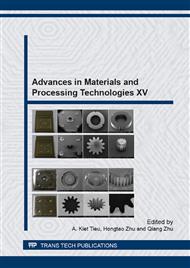[1]
M. I. Sabir, X. X. Xu, L. Li, A review on biodegradable polymeric materials for bone tissue engineering applications, J. Mater. Sci. 44 (2009) 5713-5724.
DOI: 10.1007/s10853-009-3770-7
Google Scholar
[2]
J. T. Yeh, M. C. Yang, C. J. Wu, C. S. Wu, Preparation and Characterization of Biodegradable Polycaprolactone/Multiwalled Carbon Nanotubes Nanocomposites, J. Appl. Polym. Sci. 112 (2009) 660-668.
DOI: 10.1002/app.29485
Google Scholar
[3]
I. Janigova, F. Lednicky, D. J. Moskova, I. Chodak, Nanocomposites with Biodegradable Polycaprolactone Matrix, Macromol Symp 301 (2011) 1-8.
Google Scholar
[4]
M. Diba, M. H. Fathi, M. Kharaziha, Novel forsterite/polycaprolactone nanocomposite scaffold for tissue engineering applications, Mater. Lett. 65 (2011) 1931-1934.
DOI: 10.1016/j.matlet.2011.03.047
Google Scholar
[5]
K. Saeed, S. Y. Park, H. J. Lee, J. B. Baek, W. S. Huh, Preparation of electrospun nanofibers of carbon nanotube/polycaprolactone nanocomposite, Polymer 47 (2006) 8019-8025.
DOI: 10.1016/j.polymer.2006.09.012
Google Scholar
[6]
S. Sayyar, E. Murray, B.C. Thompson, S. Gambhir, D.L. Officer and G.G. Wallace, Covalently linked biocompatible graphene/polycaprolactone composites for tissue engineering, Carbon 52 (2013) 296-304.
DOI: 10.1016/j.carbon.2012.09.031
Google Scholar
[7]
F. Hussain, M. Hojjati, M. Okamoto, R. E. Gorga, Review article: Polymer-matrix nanocomposites, processing, manufacturing, and application: An overview, J. Compos. Mater. 40 (2006) 1511-1575.
DOI: 10.1177/0021998306067321
Google Scholar
[8]
S. Y. Park, J. Park, S. H. Sim, M. G. Sung, K. S. Kim, B. H. Hong, S. Hong, Enhanced Differentiation of Human Neural Stem Cells into Neurons on Graphene, Adv. Mater. 23 (2011)
DOI: 10.1002/adma.201101503
Google Scholar
[9]
A. K. Geim, A. H. MacDonald, Graphene: Exploring carbon flatland, Phys. Today 60 (2007) 35-41.
Google Scholar
[10]
Y. Si, E. T. Samulski, Synthesis of water soluble graphene, Nano Lett. 8 (2008) 1679-1682.
DOI: 10.1021/nl080604h
Google Scholar
[11]
B. Das, K. E. Prasad, U. Ramamurty, C. N. R. Rao, Nano-indentation studies on polymer matrix composites reinforced by few-layer graphene, Nanotechnology 20 (2009) 125705.
DOI: 10.1088/0957-4484/20/12/125705
Google Scholar
[12]
H. L. Fan, L. L. Wang, K. K. Zhao, N. Li, Z. J. Shi, Z. G. Ge, Z. X. Jin, Fabrication, Mechanical Properties, and Biocompatibility of Graphene-Reinforced Chitosan Composites, Biomacromolecules 11 (2010) 2345-2351.
DOI: 10.1021/bm100470q
Google Scholar
[13]
S. C. M. Fernandes, C. S. R. Freire, A. J. D. Silvestre, C. P. Neto, A. Gandini, L. A. Berglund, L. Salmen, Transparent chitosan films reinforced with a high content of nanofibrillated cellulose, Carbohydr. Polym. 81 (2010) 394-401.
DOI: 10.1016/j.carbpol.2010.02.037
Google Scholar
[14]
I. H. Kim, Y. G. Jeong, Polylactide/Exfoliated Graphite Nanocomposites with Enhanced Thermal Stability, Mechanical Modulus, and Electrical Conductivity, J Polym Sci Pol Phys 48 (2010) 850-858.
DOI: 10.1002/polb.21956
Google Scholar
[15]
X. M. Yang, L. A. Li, S. M. Shang, X. M. Tao, Synthesis and characterization of layer-aligned poly(vinyl alcohol)/graphene nanocomposites, Polymer 51 (2010) 3431-3435.
DOI: 10.1016/j.polymer.2010.05.034
Google Scholar
[16]
E. Murray, S. Sayyar, et al. Simultaneous reduction and polymer stabilisation of graphene oxide nanosheets under microwave irradiation. Manuscript under preparation
Google Scholar
[17]
E. Sachlos, J. T. Czernuszka, Making tissue engineering scaffolds work. Review: the application of solid freeform fabrication technology to the production of tissue engineering scaffolds, Eur Cell Mater 5 (2003) 29-39.
DOI: 10.22203/ecm.v005a03
Google Scholar
[18]
S. Park, G. Kim, Y.C. Jeon, Y. Koh and W. Kim, 3D polycaprolactone scaffolds with controlled pore structure using a rapid prototyping system, J Mater Sci-Mater M. 20 (2009) 229-34.
DOI: 10.1007/s10856-008-3573-4
Google Scholar
[19]
J.-H. Lee, S.-A. Park, K. Park, J.-H. Kim, K.-S. Kim, J. Lee and W. Kim, Fabrication and characterization of 3D scaffold using 3D plotting system, Chinese Sci. Bull. 55 (2010) 94-98.
DOI: 10.1007/s11434-009-0271-7
Google Scholar
[20]
S. Gambhir, E. Murray, et. al. Extensive chemical reduction and dispersion of graphene nanosheets. Manuscript under preparation.
Google Scholar



